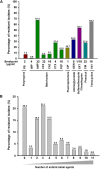Antimicrobial Resistance Profile of mcr-1 Positive Clinical Isolates of Escherichia coli in China From 2013 to 2016
- PMID: 30405572
- PMCID: PMC6206212
- DOI: 10.3389/fmicb.2018.02514
Antimicrobial Resistance Profile of mcr-1 Positive Clinical Isolates of Escherichia coli in China From 2013 to 2016
Abstract
Multidrug-resistant (MDR) Escherichia coli poses a great challenge for public health in recent decades. Polymyxins have been reconsidered as a valuable therapeutic option for the treatment of infections caused by MDR E. coli. A plasmid-encoded colistin resistance gene mcr-1 encoding phosphoethanolamine transferase has been recently described in Enterobacteriaceae. In this study, a total of 123 E. coli isolates obtained from patients with diarrheal diseases in China were used for the genetic analysis of colistin resistance in clinical isolates. Antimicrobial resistance profile of polymyxin B (PB) and 11 commonly used antimicrobial agents were determined. Among the 123 E. coli isolates, 9 isolates (7.3%) were resistant to PB and PCR screening showed that seven (5.7%) isolates carried the mcr-1 gene. A hybrid sequencing analysis using single-molecule, real-time (SMRT) sequencing and Illumina sequencing was then performed to resolve the genomes of the seven mcr-1 positive isolates. These seven isolates harbored multiple plasmids and are MDR, with six isolates carrying one mcr-1 positive plasmid and one isolate (14EC033) carrying two mcr-1 positive plasmids. These eight mcr-1 positive plasmids belonged to the IncX4, IncI2, and IncP1 types. In addition, the mcr-1 gene was the solo antibiotic resistance gene identified in the mcr-1 positive plasmids, while the rest of the antibiotic resistance genes were mostly clustered into one or two plasmids. Interestingly, one mcr-1 positive isolate (14EC047) was susceptible to PB, and we showed that the activity of MCR-1-mediated colistin resistance was not phenotypically expressed in 14EC047 host strain. Furthermore, three isolates exhibited resistance to PB but did not carry previously reported mcr-related genes. Multilocus sequence typing (MLST) showed that these mcr-1 positive E. coli isolates belonged to five different STs, and three isolates belonged to ST301 which carried multiple virulence factors related to diarrhea. Additionally, the mcr-1 positive isolates were all susceptible to imipenem (IMP), suggesting that IMP could be used to treat infection caused by mcr-1 positive E. coli isolates. Collectively, this study showed a high occurrence of mcr-1 positive plasmids in patients with diarrheal diseases of Guangzhou in China and the abolishment of the MCR-1 mediated colistin resistance in one E. coli isolate.
Keywords: Escherichia coli; clinical isolates; mcr-1; multidrug-resistant; plasmid.
Figures



Similar articles
-
mcr-Colistin Resistance Genes Mobilized by IncX4, IncHI2, and IncI2 Plasmids in Escherichia coli of Pigs and White Stork in Spain.Front Microbiol. 2020 Jan 17;10:3072. doi: 10.3389/fmicb.2019.03072. eCollection 2019. Front Microbiol. 2020. PMID: 32010114 Free PMC article.
-
Colistin-Resistant mcr-Positive Enterobacteriaceae in Fresh Vegetables, an Increasing Infectious Threat in China.Int J Antimicrob Agents. 2019 Jul;54(1):89-94. doi: 10.1016/j.ijantimicag.2019.04.013. Epub 2019 Apr 26. Int J Antimicrob Agents. 2019. PMID: 31034936
-
Prevalence of mcr-1 in Escherichia coli and Klebsiella pneumoniae recovered from bloodstream infections in China: a multicentre longitudinal study.Lancet Infect Dis. 2017 Apr;17(4):400-410. doi: 10.1016/S1473-3099(16)30528-X. Epub 2017 Jan 28. Lancet Infect Dis. 2017. PMID: 28139430
-
Detection of mcr-1 Plasmids in Enterobacteriaceae Isolates From Human Specimens: Comparison With Those in Escherichia coli Isolates From Livestock in Korea.Ann Lab Med. 2018 Nov;38(6):555-562. doi: 10.3343/alm.2018.38.6.555. Ann Lab Med. 2018. PMID: 30027699 Free PMC article.
-
Molecular mechanisms of colistin resistance in Africa: A systematic review of literature.Germs. 2020 Dec 28;10(4):367-379. doi: 10.18683/germs.2020.1229. eCollection 2020 Dec. Germs. 2020. PMID: 33489952 Free PMC article. Review.
Cited by
-
Colistin Resistance Gene mcr-1 Mediates Cell Permeability and Resistance to Hydrophobic Antibiotics.Front Microbiol. 2020 Jan 10;10:3015. doi: 10.3389/fmicb.2019.03015. eCollection 2019. Front Microbiol. 2020. PMID: 31998280 Free PMC article.
-
A Review of Resistance to Polymyxins and Evolving Mobile Colistin Resistance Gene (mcr) among Pathogens of Clinical Significance.Antibiotics (Basel). 2023 Nov 6;12(11):1597. doi: 10.3390/antibiotics12111597. Antibiotics (Basel). 2023. PMID: 37998799 Free PMC article. Review.
-
Worldwide Prevalence of mcr-mediated Colistin-Resistance Escherichia coli in Isolates of Clinical Samples, Healthy Humans, and Livestock-A Systematic Review and Meta-Analysis.Pathogens. 2022 Jun 8;11(6):659. doi: 10.3390/pathogens11060659. Pathogens. 2022. PMID: 35745513 Free PMC article. Review.
-
Investigating Possible Interspecies Communication of Plasmids Associated with Transfer of Third-Generation Cephalosporin, Quinolone, and Colistin Resistance Between Simultaneously Isolated Escherichia Coli and Klebsiella Pneumoniae.Microbiol Spectr. 2023 Jun 15;11(3):e0355422. doi: 10.1128/spectrum.03554-22. Epub 2023 May 1. Microbiol Spectr. 2023. PMID: 37125932 Free PMC article.
-
Emerging Transcriptional and Genomic Mechanisms Mediating Carbapenem and Polymyxin Resistance in Enterobacteriaceae: a Systematic Review of Current Reports.mSystems. 2020 Dec 15;5(6):e00783-20. doi: 10.1128/mSystems.00783-20. mSystems. 2020. PMID: 33323413 Free PMC article. Review.
References
-
- Afset J. E., Bruant G., Brousseau R., Harel J., Anderssen E., Bevanger L., et al. (2006). Identification of virulence genes linked with diarrhea due to atypical enteropathogenic Escherichia coli by DNA microarray analysis and PCR. J. Clin. Microbiol. 44 3703–3711. 10.1128/Jcm.00429-06 - DOI - PMC - PubMed
-
- Bai L., Hurley D., Li J., Meng Q., Wang J., Fanning S., et al. (2016). Characterisation of multidrug-resistant Shiga toxin-producing Escherichia coli cultured from pigs in China: co-occurrence of extended-spectrum beta-lactamase- and mcr-1-encoding genes on plasmids. Int. J. Antimicrob. Agents 48 445–448. 10.1016/j.ijantimicag.2016.06.021 - DOI - PubMed
LinkOut - more resources
Full Text Sources

